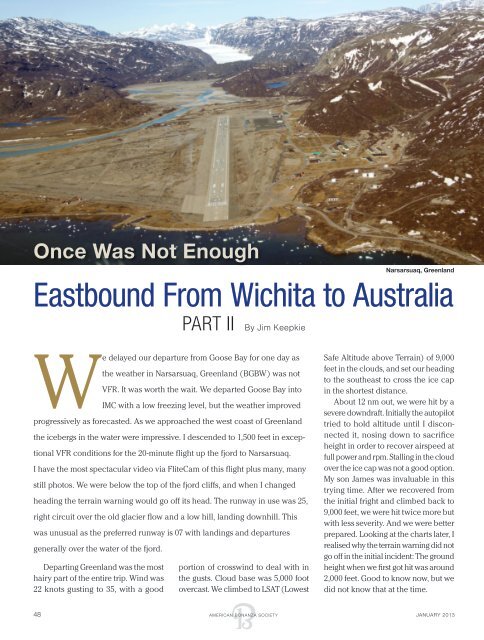Insurance Discount May Pay for Your BPPP Training - American ...
Insurance Discount May Pay for Your BPPP Training - American ...
Insurance Discount May Pay for Your BPPP Training - American ...
You also want an ePaper? Increase the reach of your titles
YUMPU automatically turns print PDFs into web optimized ePapers that Google loves.
Once Was Not Enough<br />
Narsarsuaq, Greenland<br />
Eastbound From Wichita to Australia<br />
Part II By Jim Keepkie<br />
We delayed our departure from Goose Bay <strong>for</strong> one day as<br />
the weather in Narsarsuaq, Greenland (BGBW) was not<br />
VFR. It was worth the wait. We departed Goose Bay into<br />
IMC with a low freezing level, but the weather improved<br />
progressively as <strong>for</strong>ecasted. As we approached the west coast of Greenland<br />
the icebergs in the water were impressive. I descended to 1,500 feet in exceptional<br />
VFR conditions <strong>for</strong> the 20-minute flight up the fjord to Narsarsuaq.<br />
I have the most spectacular video via FliteCam of this flight plus many, many<br />
still photos. We were below the top of the fjord cliffs, and when I changed<br />
heading the terrain warning would go off its head. The runway in use was 25,<br />
right circuit over the old glacier flow and a low hill, landing downhill. This<br />
was unusual as the preferred runway is 07 with landings and departures<br />
generally over the water of the fjord.<br />
Departing Greenland was the most<br />
hairy part of the entire trip. Wind was<br />
22 knots gusting to 35, with a good<br />
portion of crosswind to deal with in<br />
the gusts. Cloud base was 5,000 foot<br />
overcast. We climbed to LSAT (Lowest<br />
Safe Altitude above Terrain) of 9,000<br />
feet in the clouds, and set our heading<br />
to the southeast to cross the ice cap<br />
in the shortest distance.<br />
About 12 nm out, we were hit by a<br />
severe downdraft. Initially the autopilot<br />
tried to hold altitude until I disconnected<br />
it, nosing down to sacrifice<br />
height in order to recover airspeed at<br />
full power and rpm. Stalling in the cloud<br />
over the ice cap was not a good option.<br />
My son James was invaluable in this<br />
trying time. After we recovered from<br />
the initial fright and climbed back to<br />
9,000 feet, we were hit twice more but<br />
with less severity. And we were better<br />
prepared. Looking at the charts later, I<br />
realised why the terrain warning did not<br />
go off in the initial incident: The ground<br />
height when we first got hit was around<br />
2,000 feet. Good to know now, but we<br />
did not know that at the time.<br />
48 AMERICAN BONANZA SOCIETY JANUARY 2013

















